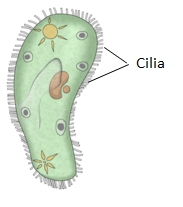9th Grade > Biology
DIVERSITY IN LIVING ORGANISMS MCQs
:
A
Pteridophytes are members of cryptogams, which means they have inconspicuous reproductive organs. Hence, Pteridophytes neither have flowers nor they produce seeds. They have naked embryos that are called spores.
:
A
Prokaryotes are organisms which lack a well-defined nucleus and membrane-bound organelles. Monera is the only kingdom which contains prokaryotic organisms. Kingdom Monera includes bacteria, blue- green algae etc.
:
C
The mode of nutrition of organisms belonging to kingdom Fungi is saprophytic. They secrete enzymes to digest dead and decaying matter and then they absorb the digested material.
:
A
∙ Thallophyta has the least tissue differentiation among all divisions of the Kingdom Plantae. This group of plants do not have specific parts like roots, stem, leaves and flower. Algae belong to this group. They are aquatic plants and reproduce through spores.
∙ Bryophytes are photosynthetic, non-vascular terrestrial plants.
∙ Pteridophytes are vascular plants (with xylem and phloem) that produces spores.
∙ Gymnosperms are group of vascular plants that do not have an outer covering or shell around their seeds. They do not produce flowers.
:
B
Robert Whittaker proposed the five kingdom classification of organisms. The five kingdoms proposed by Whittaker are Monera, Protista, Fungi, Plantae and Animalia.
:
C
Kingdom Protista consists of different types of unicellular eukaryotic organisms. E.g. unicellular algae, diatoms, protozoans etc.
Most protists are unicellular, but there are some relatively simple multicellular forms also.
:
A, B, and C
The organisms that belong to phylum Coelenterata (Cnidaria) live in water. They have cavity in their body. Their body is made of two layers of cells: inner and outer linings. Example of phylum Coelenterata includes – Hydra, Jellyfish, sea anemone etc.
:
D
The system of scientific nomenclature that we use today was first introduced by Carolus Linnaeus. He proposed the binomial system of nomenclature, according to which the names of organisms will have two parts- genus and species.
:
C
Arthropod means jointed legs. Animals which have jointed appendages belong to this phylum. This is the largest phylum in the animal kingdom. Butterflies are insects and hence they belong to the phylum Arthropoda.

















